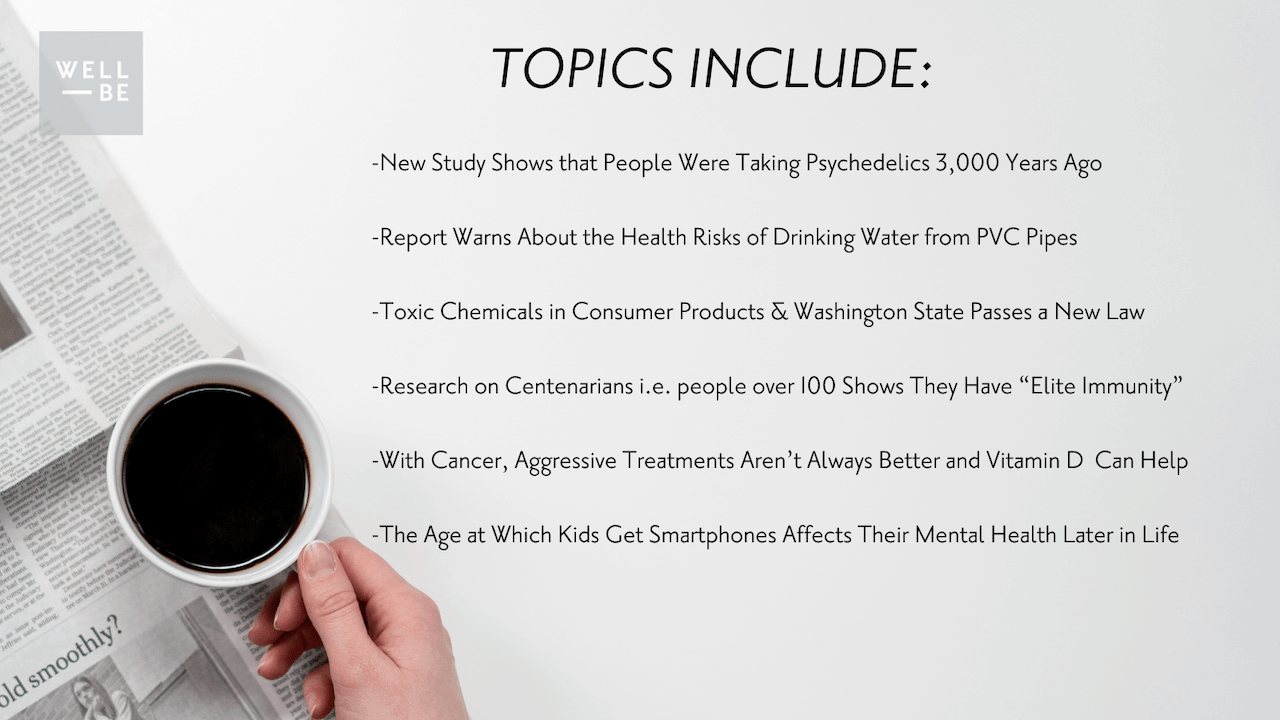Welcome to the second health research and wellness news wrap-up of 2023! As with all our wrap-ups, we’ll cover the most important pieces of health research and wellness news you need to know right now. To put this together, we combed through everything health-related that happened since our last wrap-up, covering health research findings and news that came out in April through June 2023.
In this wrap-up, we’re featuring six big health stories, plus a few notable updates and interesting tidbits at the bottom.
So without further ado, we present the 6 most important health and wellness news stories to know about today (click to skip to one):
- New Study Shows that People Were Taking Psychedelics 3,000 Years Ago
- Report Warns About the Health Risks of Drinking Water from PVC Pipes
- Toxic Chemicals in Consumer Products: Report Shows They’re Everywhere & Washington State Passes a New Law
- Research on Centenarians i.e. people over 100 Shows They Have “Elite Immunity”
- With Cancer, Aggressive Treatments Aren’t Always Better (and Vitamin D Shown to Help)
- The Age at Which Kids Get Smartphones Affects Their Mental Health Later in Life
You can also listen to the wrap-up on The getWellBe Podcast.
1. New Study Shows that People Were Taking Psychedelics 3,000 Years Ago
What: Findings discovered in Spain provide nearly definitive evidence that people in Europe were taking hallucinogenic substances around 3,000 years ago. Around the same time, the FDA has cleared a path for psychedelic drug trials.
The Details: Researchers discovered hair at a burial site in Menorca, Spain, that contained three psychoactive substances: atropine and scopolamine, which induce hallucinations, as well as ephedrine, which boosts energy and alertness (ephedrine is an active ingredient in meth and used to be in diet pills, if it sounds familiar).
The locks of hair were found in a large cave that contains more than 200 graves and is thought to have been an important site for funerals and burial-related rituals. Researchers believe the hallucinogens may have been used for the rituals held at the cave.
The findings, which were published in the journal Nature, are the earliest pieces of direct evidence of our ancient ancestors taking hallucinogenic drugs. In the past, researchers had reason to believe that prehistoric drug use went on, but only through indirect evidence like depictions of psychoactive plants in drawings or paintings.
Meanwhile, the FDA laid out draft guidelines for researchers looking into how psychedelics like psilocybin, LSD, MDMA, and others could be used for a variety of different mental and physical health conditions.
Why This Matters for Your Health & Our Takeaway: We’ve been closely watching the exciting developments in the world of psychedelics and our health (check out our interview with Dr. Fred Barrett, director of the Center for Psychedelic and Consciousness Research at Johns Hopkins University), and these new findings show that these powerful substances have had a place in human life for far longer than we previously knew. We’re not saying that this means we should all run out and drop some LSD right now, but it does suggest that, perhaps, these potent plants exist for a reason, and there are things to be learned from them. Considering all the serious side effects that tend to come with man-made pharmaceuticals, we see this emerging field as holding great potential for developing medicines that are both natural and effective. We’re excited to see what happens now that the FDA has cleared a path for these substances to be used for good!
If you’re curious to read more about psychedelics and our health, check out some of our previous wrap-ups to learn about a breakthrough on how psychedelics affect our neurons, the remarkable effects of magic mushrooms for treating depression, and why researchers at Johns Hopkins are calling for psilocybin (the active ingredient in hallucinogenic mushrooms) to be legalized. And stay tuned for a new interview on the topic later this summer!
2. Report Warns About the Health Risks of Drinking Water from PVC Pipes
What: A coalition of U.S. environmental advocacy groups issued a report warning about the health risks of using PVC plastic to make pipes that transport drinking water, and urged public officials to choose different, safer materials.
The Details: The report, released by the environmental nonprofit Beyond Plastics and two other groups, outlined the health consequences of drinking water that comes through PVC pipes. PVC stands for polyvinyl chloride, which is made from vinyl chloride — the very same toxic material that was released during the train derailment in Ohio earlier this year that triggered a public health crisis. Vinyl chloride is known to increase cancer risk and can cause hormone disruption, and according to the report, there is legitimate reason to believe that chemicals from the PVC pipes can leach into the drinking water itself. The Consumer Product Safety Commission banned the use of vinyl chloride in aerosols way back in 1974, but it’s still allowed to be used on other products (like drinking water pipes…!).
The PVC pipe market is on the rise, and is largely being used for water, sewage, and irrigation projects — a recent survey found that contractors, engineers, and municipal officials anticipate using PVS in almost two-thirds of all their upcoming water projects. And the reason so many pipes are being made with PVC these days is, ironically, because of an effort meant to protect our health: in 2021, the Biden administration allocated $15 billion through the EPA’s Drinking Water State Revolving Fund to help communities across the country replace harmful lead pipes with safer alternatives. The issue? They gave no guidance at all on what those alternatives should be, and since PVC is cheap, it became the default.
The report authors said that communities should choose safer alternatives like stainless steel and copper, even though they are more expensive.
Why This Matters for Your Health & Our Takeaway: Despite headlines you might read about efforts to protect public health (like, for instance, the allocation of funds to replace lead pipes), it’s important to remember that, unfortunately, big companies and big government don’t have your health at the front of their mind (if they did, wouldn’t they have done extensive testing and specified what the pipes should be made of?). As always, you need to be your own best advocate and protector when it comes to your health — and though you can’t control what kind of pipe the water you drink or shower in comes through, you can take steps to filter out any harmful contaminants. Check out our water filter guide to learn which water filter is the best choice based on where you live.
3. Toxic Chemicals in Consumer Products: Report Shows They’re Everywhere & Washington State Passes a New Law
What: Recent research shows that hazardous chemicals are present in more common consumer products than we previously thought, but a new law in Washington State provides a bit of hope that this might change.
The Details: According to research published in May in the journal Environmental Science & Technology, more than 100 types of common consumer products contain at least — one and often several — chemicals known to cause health problems. The researchers identified 33 different volatile organic chemicals (V.O.C.s) that are known to be hazardous to human health in products across 105 different consumer categories. Some of the most concerning chemicals were diethanolamine, which is known to potentially cause cancer and is banned in Canada and the EU, and formaldehyde, which is also a known carcinogen. Other chemicals on the list are linked to hormone disruption, reproductive issues, and developmental delays, among other serious health problems. What’s more, since V.O.C.s are released into the air, the potential hazardous health effects of these chemicals aren’t limited to the person using the product, but can also do harm to those in their home, including young children.
About two-thirds of the products researchers identified as containing toxic chemicals were personal care products, like shampoo, lotion, and soap; household cleaning products also contained numerous chemicals. Thankfully, you have The WellBe Non-toxic Product Database with tons of non-toxic personal care and household cleaning options!
Those findings are pretty grim, but at least one state is taking action to stem the tide of harmful chemicals in our homes. Back in April, the Washington state legislature passed the Toxics-Free Cosmetics Act, which is currently the country’s strongest law against toxic cosmetics. Under the new law, which takes effect in 2025, cosmetics companies are banned from manufacturing, selling, or distributing cosmetics that contain certain chemicals and chemical classes. The banned chemicals include formaldehyde, lead, mercury, and PFAS, also known as “forever chemicals” (which, if you’ll remember from last October’s wrap-up, can quadruple your risk of developing liver cancer and are regulated in public drinking water). Companies that violate the new law will face a $10,000 fine per offense, but they have until 2026 to sell off existing stock that contains these chemicals.
It’s worth noting that there are other laws regulating the use of hazardous chemicals in personal care and cosmetic products, but they’re all much weaker than this new Washington law. On a federal level, the FDA only regulates a small number of chemicals found in beauty products, and most others are regulated by a patchwork of state-level laws or left completely to the discretion of the manufacturer.
Why This Matters for Your Health & Our Takeaway: If you live in Washington state — hooray for you! You’re about to be much more protected against toxic chemicals than the rest of us (though, of course, remember that only nine chemicals are regulated, and there are plenty more harmful ones out there…). But for those of us not in Washington state, we should pay close attention to this alarming new report about harmful chemicals in consumer products. Because even while the amount of chemicals in the products might be relatively low, these are products we use over and over again — maybe every day or multiple times a day — and so the exposure builds up over time, which can lead to adverse health outcomes. Your best bet? Replace all your conventional personal care and household products with ones that have been vetted as containing zero harmful substances. With 2,000+ products across 20+ different categories, our Non-Toxic Product Database is a great place to start.
4. Research on Centenarians (i.e. People Over 100) Shows They Have “Elite Immunity”
What: Researchers looking into what allows some people to live past the age of 100 have discovered that centenarians have uniquely effective immune systems.
The Details: The study, published in The Lancet journal in early April, involved sequencing the immune cells circulating in the blood of seven centenarians. When they cross-referenced their data with publicly available databases and performed complex computational techniques, they found that the subjects’ immune cells remained highly functional even in their old age. This is in contrast to the typical pattern seen in people, where the immune system generally becomes less responsive and adaptable as a person ages.
What’s more, the immune profiles they observed showed not that these centenarians had managed to avoid infection, but that they had a long history of exposure to infections and an increased capacity to recover from them. They don’t yet know whether this enhanced immunity is because of genetics, lifestyle, both, or a confluence of multiple factors.
Why This Matters for Your Health & Our Takeaway: We all want to live long, healthy lives, and according to this research, the key to that is your immune system. That makes sense, right? Ultimately, these findings show that your longevity is equal to your ability to fight off infection, and so increasing immune resilience is the best thing you can do for your lifelong health and longevity. Of course, that’s easier said than done — the immune system is infinitely complex. But because we know that your gut health is closely connected to your immune function, focusing on things that impact gut health is a great place to start. That means not only what you eat, but also your stress levels, your sleep, the medications you take, and more. To make sure you’re doing the right things to support your gut, download our free guide to improving gut health.
5. With Cancer, Aggressive Treatments Aren’t Always Better (and Study Shows Vitamin D Can Help)
What: Based on an abundance of recent research, oncologists are beginning to understand that less aggressive treatments might actually be a better choice for treating cancer, while one new study suggests a less aggressive alternative for preventing cancer: vitamin D supplementation.
The Details: At the American Society of Clinical Oncology conference in Chicago earlier this year, there were several presentations driving home the same point: some patients do better with noninvasive surgery or treatments. A study of patients with pancreatic cancer showed that patients who had laparoscopic surgery (robot-assisted, minimally-invasive surgery) had similar outcomes to patients who underwent more invasive open surgery; another study showed that women with cervical cancer who had a simple hysterectomy (meaning just the uterus and cervix was removed) had similar outcomes and fewer adverse side effects than women who had a radical hysterectomy (surgery that removes the uterus, cervix, part of the vagina, and a wide area of ligaments and tissue around these organs); yet another study showed that rectal cancer patients who opted for stronger chemo but skipped radiation had similar outcomes to patients who got both chemo and radiation.
All of these studies are part of a growing body of evidence behind a strategy called “de-escalation,” or an effort to design cancer treatments that reduce side effects and cost and improve patient quality of life without hurting their odds of survival.
Speaking of side-effect-free interventions that can help fight against cancer, a recent study out of Germany found that taking a daily vitamin D supplement can significantly reduce cancer risk. Researchers analyzed data from 14 studies, which included over 100,000 participants total (that’s a lot!), that compared people taking vitamin D3 to those taking a placebo. While taking large amounts of vitamin D intermittently seemed to have no effect on cancer mortality, they found that participants who took vitamin D3 daily and consistently reduced their cancer mortality rate by 12% (meaning it was better to take the same 1 pill every day than 3 pills twice a week). The benefits were particularly pronounced for people over age 70 who started taking vitamin D before getting a cancer diagnosis.
Why This Matters for Your Health & Our Takeaway: Well consider us thrilled about this whole “de-escalation” concept! It’s basically what we’ve been saying for years: the best thing you can do is take measures to prevent disease, but once it’s set in, you should always choose the least invasive option with the fewest side effects (which is why we love the idea of naturopathic oncology). It’s amazing to see researchers and conventional doctors coalescing around the same idea. Let’s say it together now: more aggressive doesn’t mean more effective!
In the meantime, let’s all add a vitamin D3 supplement to our daily routine (if you haven’t already). If you live above a certain latitude chances are you need one anyway! You’ll find practitioner-grade vitamin D brands in the WellBe Non-toxic Product Database, though we always recommend getting your vitamin D levels checked first with a blood test before determining the right daily dose.
6. The Age at Which Kids Get Smartphones Affects Their Mental Health Later in Life
What: A recent study from the think tank Sapien Labs found that there’s a strong correlation between when a young person gets their first smartphone and their mental well-being throughout life.
The Details: The global study included almost 30,000 young adults from around the world, and examined the relationship between mental health and when each subject got their first smartphone. The results were clear: the later a person got a smartphone or tablet they could carry around with them during childhood, the better their mental well-being as young adults. Receiving a smartphone or tablet later in life was associated with more self-confidence and a better ability to relate positively to others, while getting a smartphone at a younger age was associated with more suicidal thoughts, feelings of aggression toward others, and a detachment from reality. Every year delay in getting a smartphone or tablet made a difference in mental health later in life.
While these trends were stronger in females than in males, they were seen across both sexes, and were consistent in all parts of the world that were included in the study (which was basically the entire world).
Why This Matters for Your Health & Our Takeaway: There’s no denying that there’s a mental health crisis among young people today — rates of depression, anxiety, suicidal thoughts, eating disorders, and other mental health issues are on the rise, and there’s strong evidence to suggest that smartphone, internet, and social media use are playing a role in this trend.
If you’re a parent, this study should provide you with a bit of clarity on how to handle devices with your kiddos, as well as a bit of hope that there are concrete things you can do to protect them from the negative effects of technology (specifically, waiting until they’re well into adolescence before giving them a smartphone). And if you’re not a parent, this study should still provide a little guidance: if devices are doing this much measurable harm to kids, chances are they’re not doing great things for adults either. It might be smart to start setting some boundaries around your phone, whether that’s daily screen time limits, a device-free room in your home, one unplugged day a week, or whatever else works for your life.
Other news & updates:
- As we reported back in October, Johnson & Johnson’s baby powder was pulled from shelves amid ongoing lawsuits claiming that asbestos in the powder causes cancer. Now, the company has reached an $8.9 billion settlement with plaintiffs in the various cases.
- A new study is suggesting that those with a high genetic risk for type 2 diabetes can reduce their risk of getting the disease with moderate-vigorous physical activity aka exercise, showing once again that genes are not fate.
- Researchers have previously hypothesized that our more sedentary lifestyles are at the root of rising obesity rates. But new research suggests that it’s not due to less physical activity, but rather to declining basal metabolic rates, aka how many calories our body burns simply by maintaining our basic bodily functions, like breathing and metabolizing food. They’re not sure why this is happening, but they hypothesize that it may be because of our changing diet over time; in terms of what it means for your daily life, the takeaway here is that, unfortunately, exercise alone is unlikely to prevent obesity if you’re eating more than your body needs.
- Ozempic has been grabbing headlines left and right since it received approval as a weight loss drug, but there’s been very little research or publicity around side effects and long-term repercussions. Now, doctors are reporting a surge in ER visits among Ozempic users due to the drug’s adverse effects — which range from diarrhea and bloating to kidney failure, gallstones, and more.









COMMENTS